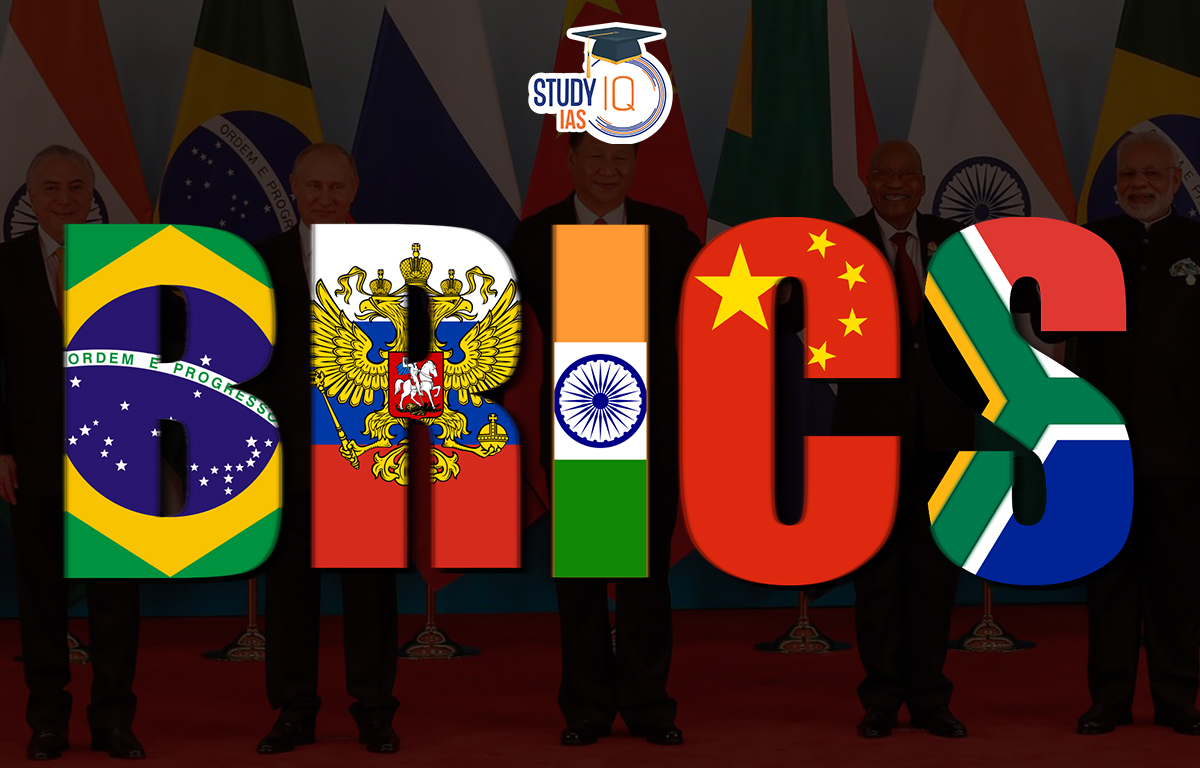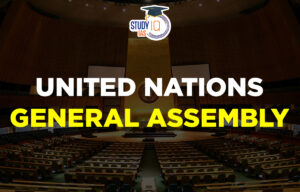Table of Contents
Context: The BRICS Parliamentary Forum condemned the Pahalgam terror attack and pledged collective action against terrorism. Recently, Indonesia was admitted as a full member of the BRICS bloc. Its inclusion was announced by Brazil (chair for 2025).
BRICS Full Form
BRICS stands for Brazil, Russia, India, China, and South Africa, and it refers to a group of five key emerging economies. The acronym BRIC was coined by economist Jim O’Neill in 2001 to designate the four rapidly growing economies of Brazil, Russia, India, and China. In 2010, South Africa joined the organisation, and the acronym was modified to BRICS.
Since this is a prominent topic in the Indian Politics and International Relations of General Studies Paper 2 and Economics of General Studies Paper 3 of the UPSC Syllabus, this article is crucial for students preparing for the IAS exam.
About BRICS Countries Group
The BRICS Countries are all significant players in their fields and contributors to the global economy. Collectively, the BRICS Group represent approximately 49.5% of the global population, around 40% of the global GDP, and about 26% of global trade.
| About BRICS Group | |
| Headquarters | BRICS Tower, Shanghai, People’s Republic of China |
| First Summit | June 23, 2022 |
| Established | It is an intergovernmental organisation established on 16 June 2009.
|
| Members | Total Members: 11
|
| Principles |
|
History of BRICS
- BRICS originated from the 2001 Goldman Sachs report that highlighted the future global influence of Brazil, Russia, India, and China.
- The first formal BRICS Summit took place in 2009 in Yekaterinburg, Russia. Since then, the annual summits have become significant diplomatic events, where leaders discuss pressing global challenges, such as economic recovery, sustainable development, and global governance reforms.
- Over time, BRICS has evolved beyond an economic concept into a key political entity advocating for a multipolar world.
- There is no formal application process to join BRICS, but new members must be unanimously approved by existing ones.
BRICS Summit
- 1st BRIC Summit (2009): Yekaterinburg, Russia
- Most Recent:
- 16th Summit 2024: Kazan, Russia.
- 15th Summit (2023): Johannesburg, South Africa.
- Chairship: Rotates annually among Brazil, Russia, India, China, and South Africa.
- 2025: Brazil
Check here for complete details about the BRICS Summit
Objectives of BRICS Countries
- The BRICS Countries have established a variety of cooperative projects and institutions, such as the BRICS Business Council and the New Development Bank, to promote economic cooperation and development among themselves (formerly known as the BRICS Development Bank).
- Additionally, they participate in annual conferences where they coordinate their positions on critical international problems like trade, climate change, and international security.
- Although the BRICS countries have many characteristics, such as large populations and rapid economic growth, they also face unique challenges and have distinct political and cultural histories.
- As a result, cooperation among the BRICS nations can be difficult, but their combined power is visible, and their influence in both the political and economic realms is likely to grow in the coming years.
BRICS Headquarters
The headquarters of the BRICS institutions are located in different member countries, as follows:
- New Development Bank (NDB): The NDB, formerly known as the BRICS Development Bank, is headquartered in Shanghai, China.
- Contingent Reserve Arrangement (CRA): The CRA is a financial safety net that was established by the BRICS countries to provide short-term liquidity support to each other. The CRA is headquartered in Moscow, Russia.
- BRICS Business Council: The BRICS Business Council is a mechanism for promoting trade and investment among the BRICS countries. The council’s headquarters are located in Johannesburg, South Africa.
- The BRICS Academic Forum: It is a network of universities and research organisations dedicated to promoting academic cooperation among the BRICS countries. The forum is presided over by a rotating president, with each member country hosting the meeting during its tenure.
About BRICS Countries
The BRICS are a group of five large emerging economies that have been designated as some of the world’s fastest-growing economies. The BRICS Countries are as follows:
- Brazil, the largest country in South America, has a diverse economy that includes manufacturing, agriculture, and natural resources such as oil and minerals.
- Russia is the world’s largest country by land area, with a highly developed economy fueled mostly by its oil and petrol sector.
- India is the world’s second-most populated country, with a rapidly rising economy that includes manufacturing, agriculture, and services such as information technology and outsourcing.
- China is the world’s second-largest economy and the most populous country. It is well-known for its exports, manufacturing industry, and technological advances.
- South Africa, Africa’s southernmost country, has a diverse economy that includes industry, tourism, and mining.
BRICS Working Mechanism
BRICS operates through a rotating presidency, with each member country setting the summit agenda annually. The group hosts numerous meetings, such as ministerial gatherings, working groups, and people-to-people exchanges. Key areas of cooperation include:
- Economic and Financial Cooperation: The establishment of the New Development Bank (NDB) and Contingent Reserve Arrangement (CRA) offers financial support for member nations, promoting development and providing financial stability.
- Political and Security Cooperation: BRICS emphasizes global governance reform, counter-terrorism measures, and cybersecurity.
- People-to-People Exchanges: These exchanges foster cultural, academic, and youth partnerships across the nations.
- Health, Science, and Technology: Joint efforts in vaccine development, climate resilience, and innovation reflect BRICS’ commitment to advancing mutual technological and scientific growth.
Important Initiatives of BRICS
- New Development Bank (NDB): It was established during the 6th BRICS Summit held in Fortaleza (2014).
- Contingent Reserve Arrangement (CRA): It is a financial safety net to provide short-term liquidity support to member countries facing balance of payments difficulties. It was established in
BRICS Countries: Purpose and Significance
Brazil, Russia, India, China, and South Africa (BRICS) are significant in various fields, particularly in international relations, economics, and global governance. Here are a few examples of how the BRICS is important:
Economic Importance
The BRICS countries are among the world’s fastest-growing economies and account for a sizable part of global GDP. They have large and growing consumer markets, as well as abundant raw materials, energy, and other resources. The BRICS have created a number of cooperative projects and organisations to promote economic cooperation and development among themselves.
Geopolitical Importance
The BRICS nations have become more significant in international affairs and are major powers in their home regions. Although the political systems, customs, and viewpoints of the BRICS countries are extremely diverse, they all share a desire to advance multipolarity and change the global governance system.
Strategic Importance
The BRICS nations have advantageous geographic locations and formidable military and diplomatic capacities. They have established numerous significant partnerships and alliances in the defence, energy, and space exploration industries.
Developmental Significance
The BRICS countries house a sizable proportion of the world’s population and have made great progress in human development indicators such as education, health, and poverty reduction. They have established several initiatives and organisations to support long-term growth and social advancement.
Foundational Ideas And Operational Pillars Of BRICS
- BRICS operates on the principles of non-interference, equality, and mutual benefit.
- The alliance focuses on economic collaboration, territorial integrity, and the resolution of political disputes.
- Three Operational Pillars:
- Political and security cooperation.
- Economic and financial collaboration.
- Cultural interactions and people-to-people exchanges.
- BRICS has developed cooperative initiatives across various sectors, including energy, health, education, science and technology, innovation, trade promotion, and combating transnational crime
Functions of BRICS
- Annual Summits: Since 2009, BRICS countries have held annual summits to discuss and coordinate their efforts, starting with the first summit in Yekaterinburg.
- Significant Initiatives:
- During the 2014 Fortaleza Summit, the New Development Bank (NDB) was established, and the Contingent Reserve Arrangement (CRA) was set up to support financial stability.
- The NDB has sanctioned approximately $8 billion for renewable energy and infrastructure projects within the BRICS nations.
- Contingent Reserve Arrangement (CRA): The BRICS nations also established the Contingent Reserve Arrangement (CRA), a liquidity mechanism designed to support member countries facing payment difficulties.
- BRICS Interbank Cooperation Mechanism: The BRICS grouping has also created the BRICS Interbank Cooperation Mechanism that provides an Extending Credit Facility in Local Currency and the BRICS Exchanges Alliance.
- BRICS countries in 2018 agreed upon a non-binding and voluntary Working Mechanism for identifying, preventing and eliminating technical barriers to trade with a view to facilitating trade and increasing mutual trade flows.
- During the 2014 Fortaleza Summit, the New Development Bank (NDB) was established, and the Contingent Reserve Arrangement (CRA) was set up to support financial stability.
Cooperation Mechanisms
- Track I: Formal diplomatic engagements between national governments.
- Track II: Interactions through government-affiliated institutions.
- Track III: Civil society and people-to-people engagements.
Impact of BRICS Countries
- Institutional Reforms: BRICS has been a key player in pushing for reforms within the International Monetary Fund (IMF).
- Reducing Western Dominance: The alliance has worked towards reducing Western economic hegemony, reflecting changes in the global economic landscape.
- Financial Stability: Successfully provided short-term liquidity solutions, such as currency swaps, to address immediate financial needs.
- Global Governance: Strengthened principles of respect for sovereign equality and pluralism in global governance, advocating for a more inclusive international system.
Significance
Four out of five members in BRICS are the largest developing countries of the world, representing 41% of the global population, 24% of the global GDP and 16% of the global trade.
- Goldman Sachs claimed that the four BRIC economies will dominate the global economy by 2050.
- For years, China, India, Brazil, Russia, and South Africa were ranked among the world’s fastest-growing and emerging market economies.
- The comparative advantage of this group is their low labour costs, favourable demographics, and abundant natural resources at the time of the global commodities boom.
- BRICS countries have been the main engines of global economic growth over the years.
| UPSC PYQ |
Q. The ‘Fortaleza Declaration’, recently in the news, is related to the affairs of? (2015)
Ans: B Q. Consider the following statements with regard to BRICS: (2025)
Which of the statements given above is/are correct?
Answer: A |
| Other Important Articles | |
| G7 Countries | NATO Countries |
| International Monetary Fund | BIMSTEC Countries |


 United Nations General Assembly (UNGA), ...
United Nations General Assembly (UNGA), ...
 Universal Postal Union (UPU), Objective,...
Universal Postal Union (UPU), Objective,...
 World Meteorological Organisation (WMO),...
World Meteorological Organisation (WMO),...

























